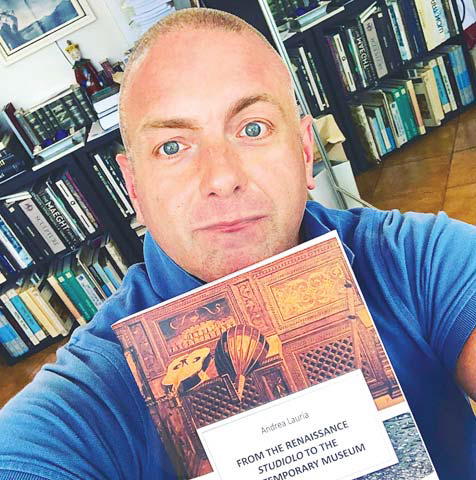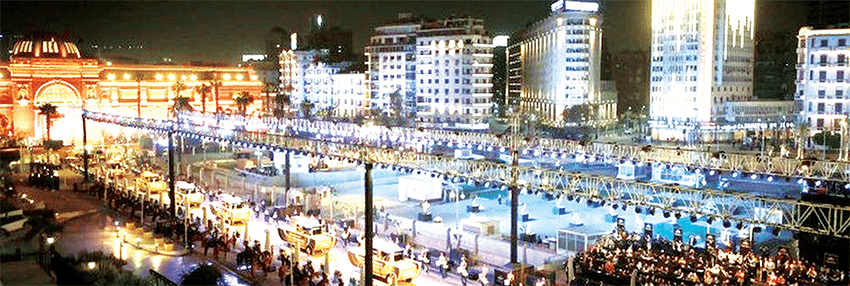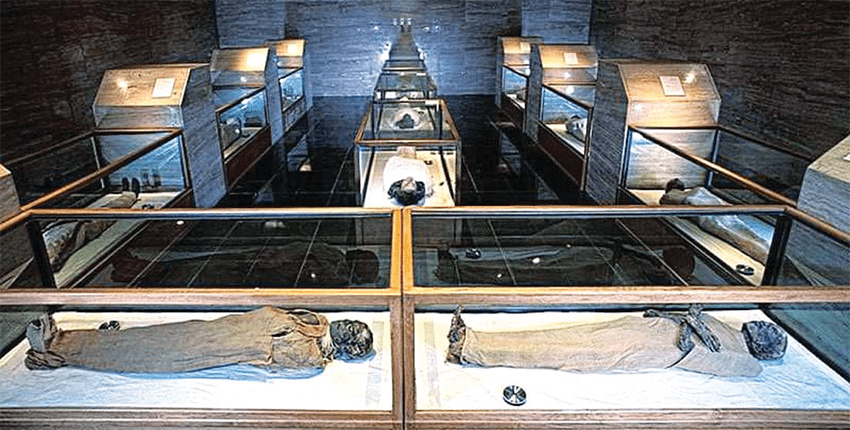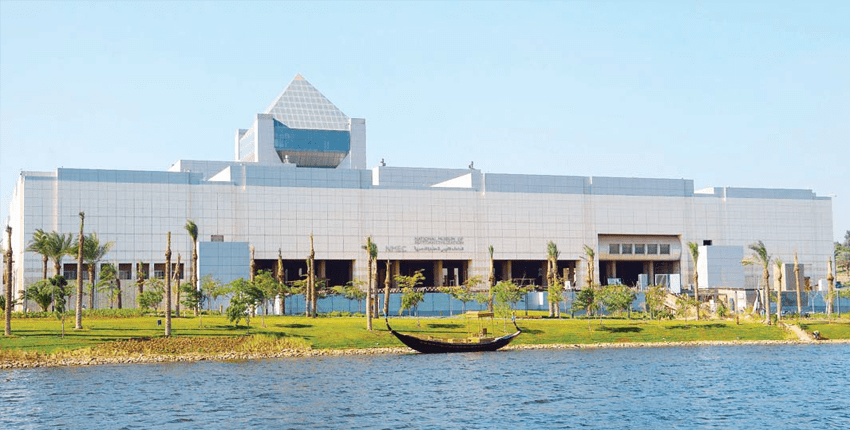13/04/2023
13/04/2023
Prof. Andrea Lauria is an Italian museologist graduated from Rome’s Accademy of fine arts. He also holds a History of Art degree from University di Roma Tre in Rome. Andrea Lauria lectures a Masters course in museology at Rome’s Universities Tor Vergata and American Temple University (Rome Campus). In 2020 he has become a published author of the book: ‘From the Renaissance studiolo to the contemporary museum’ which is also his course manual. Lauria’s field of research is the phenomenon of hyper-museums with special attention to the Arabian countries in comparison with the western world.

In addition to the Gulf countries, the phenomenon of hyper-museums has also begun in Egypt which, despite not having the same economic resources as the UAE, Kuwait, or Qatar, has nevertheless understood the media power of hypermuseums and how through the hyper-museums they can change the image of their country.
The two Egyptian hyper-museums are the National Museum of Egyptian Civilization (NMEC) inaugurated in 2021 and the Grand Egyptian Museum (GEM) that will be established probably on 2023, both are located in Cairo. Even if the Egyptian hyper-museums are different from the Gulf hyper-museums, they are still interesting to analyze, but let’s see together why the Egyptian museums are different from the museums of the Gulf. Today I will analyze with you The National Museum of Egyptian Civilization (NMEC) the first of both to be established.

The museum is located in the al-Fustat area, near Fort Babylon where it overlooks Lake Ain Essaira. The museum occupies an area of approximately 33.5 acres, including 130,000 square meters of buildings, and is expected to house 50,000 artifacts from various eras of Egyptian history. The collection will cover the time span from ancient Egypt to the country’s contemporary history.
The National Museum of Egyptian Civilization is the first of its kind in Egypt and the Arab world which provides a comprehensive view of Egyptian civilization from prehistoric times to the present day by highlighting the interaction between Egyptians and the land on which they have lived throughout history through cultural themes chosen to shed light on Egypt’s material and non-material heritage. After a partial opening in February 2017, the museum was officially established on April 3th 2021 by President Abdel Fattah El-Sisi, at the end of the transfer of 22 mummies from the Egyptian Museum located in Tahrir Square. The transfer of the 22 mummies took place during a ceremony called The Pharaoh’s Golden parade, an international mediated event that had a huge television audience success that actually was very interesting and we will analyzed it after better.

The project for the establishment of the National Museum of Egyptian Civilization dates back to 1982, the year in which UNESCO announced an international competition for the establishment of the National Museum of Civilization and the Museum of Nubia in Aswan. Initially the museum should have been built in the center of old Cairo but later, in 1999, the current location, in al-Fustat, was decided. Excavations for the museum began in 2000 and the first stone of the building was laid in 2002.
The construction of the museum was financed entirely by Egypt, while UNESCO provided technical and scientific support in the design of the museum. The museum was designed by the Egyptian architect Al-Ghazali Kasiba, professor of architecture at the Cairo School of Fine Arts, while the internal exhibition halls were designed by the Japanese architect Arata Isozaki (Oita, 1931). Why did I tell you that Egyptian hyper-museums are different from the hyper-museums of the Arabian Peninsula? If the Louvre Abu Dhabi is a perfect example of a hyper-museum, we see that the National Museum of Egyptian Civilization (NMEC) does not have the same features. The NMEC is certainly a strong landmark because it is huge with imposing volumes and has a strong visual impact on the territory. Its opening has brought enormous benefits to the area where it was built by redeveloping the area from an urban and naturalistic prospective.

The area was neglected and the Lake Ain Essaira was polluted. Now the neighborhood has been redeveloped and the lake has been cleaned up, making it accessible to citizens. The lake has become even more beautiful thanks to the creation of a beautiful museum’s park that links the museum to the lake. Although the museum is a strong landmark and has the services that are found in all museums today, we certainly cannot say that the museum is the first work of art in the collection. As I explained in my first article the hyper-museum must be the first work of art of the collection so must be the reason why we go to see that museum. When we go to visit the Guggenheim in Bilbao or the Louvre A.D. We do it because first of all we want to see those beautiful museums not because of the collection.
The NMEC it is certainly not the case, it doesn’t have the shape of a sculpture like the majority of hyper-museums which all have a strong architectural personality, the NMEC is just an imposing container. I have told you that the museum was inaugurated in 2021 but in reality it is not finished and it is only partially visible but this is a typical Egyptian custom of opening unfinished and only minimally accessible buildings. I honestly don’t understand this Egyptian custom but I’m Italian so maybe that’s the problem… Anyway even if it is not possible to evaluate the effectiveness of the museum layout - as it is only minimally open - the internal Main hall’s layout, designed by the Japanese architect Arata Isozaki, looks very interesting.
The museum’s goal is to present the Egyptian civilization from prehistoric times to the present day using various methods, from the traditional ones with the display of artifacts to the most innovative ones thanks to new technological tools. The museum is therefore not a space in which to exhibit only works of art or archaeological finds but, by undertaking a new museological approach, it also wants to be a kind of conceptual exhibition highlighting not only the physical but also the moral heritage of the country. The Main hall is equipped with induction plates and indicative signs Mummies are displayed through multi Media screens and new devices, they will be displayed in a unique manner with interactive displays and “3D hologram.” The visitor feels inside a real cemetery, and I must say is really cool and contemporary way to present ancient artefacts. The permanent collection in the Main hall is divided into two separate zones, one chronological and the other thematic. The chronological areas are as follows: Archaic, Pharaonic, Greco-Roman, Coptic, Medieval, Islamic, Modern and Contemporary.
The future museum’s collections will be displayed in nine rooms, including a large permanent exhibition on the most important achievements of Egyptian civilization, with six thematic exhibitions covering the dawn of civilization, the Nile, writing, state and society, culture, beliefs and ideas and the Royal Mummies Exhibition. The museum includes large temporary exhibition spaces, a hall and a research center, as well as an exhibition related to the development of the new city of Cairo. It will serve a variety of events, including film screenings, lectures and cultural activities, and will cater for local, national and international audiences. The museum will include service, commercial, recreation and research buildings and a research center for ancient materials and restoration.
Besides the Main hall another exhibition place that has been opened is The Royal Mummies hall which is located beneath the Main Hall, it is reached by a downward stairway at the entrance of the Main Hall of the museum. The entrance to the Royal Mummies hall was designed to feel like a tomb, the entrance resembles a cave preparing the visitors for the atmosphere of the tomb in the Valley of the Kings. Once inside, visitors can follow the direction arrows on the fl oor to go through the passages, tour the entire hall, and see all the mummies, most of which are showcased next to the coffins they were found in.
The Mummies hall houses 20 royal mummies, including 18 kings, and two queens from the 17th to 20th dynasties. The most important of these mumayauts are the mummy of King Sahun Ra, King Thutmose III, Queen Hatshepsut, King Ramses II and King Ramses III.
If the NMEC is not particularly intriguing for its architecture what made it very interesting from a media perspective and for the study of hyper-museums was its inauguration. The inauguration ceremony was actually an impressive parade, a show that lasted 2 hours and 15 minutes and entitled The Pharaoh’s Golden parade. During the parade, 22 mummies (including 18 pharaohs and 4 queens), from the New Kingdom of Ancient Egypt, were transferred from the Egyptian Museum located in Tahrir Square to the National Museum of Egyptian Civilization. The show was impressive and very close to the cinematographic colossal.
Nothing has been overlooked, not only the Egyptian costumes and the thousands of extras, but also the city, the natural setting for the event, has been restored and embellished for the parade. The director of the event was the award-winning Ahmed El- Morsy, winner of many awards and who gave a decidedly cinematic cut to the direction of the event, with the involvement of thousands of extras in Egyptian costumes but also caparisoned horses and chariots as well as a massive band. The Pharaohs’ Golden Parade was not just only a transfer of the royal mummies from one, the Egyptian museum in the Tahrir square, to another, the NMEC, but a media event aimed at spreading a new image of the country. By Andrea Lauria


